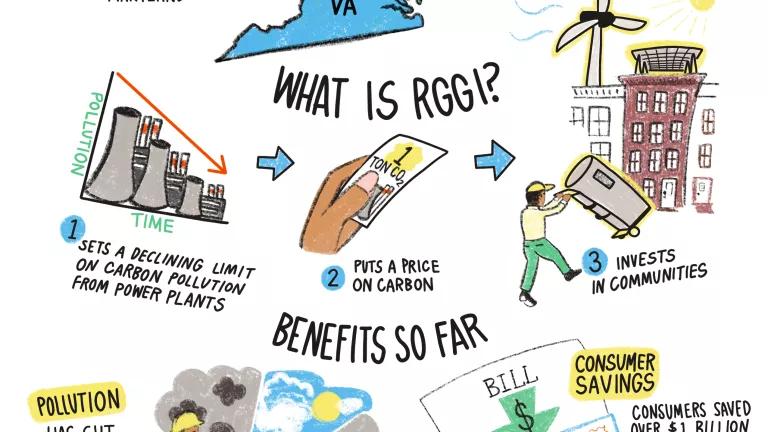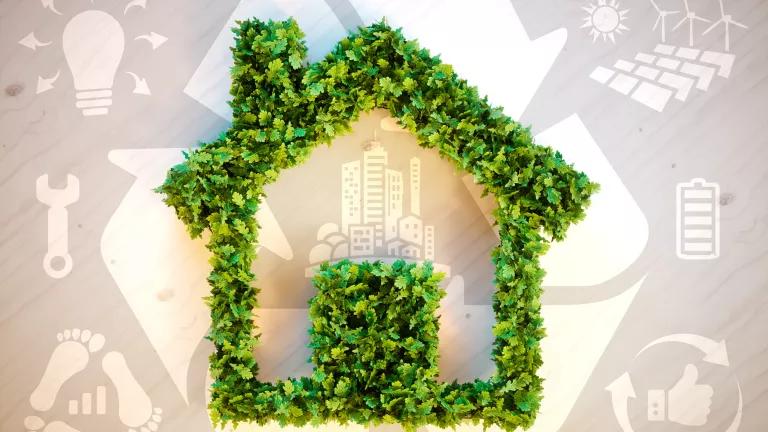RGGI's Record of Success, and What PA Stands to Gain

This is the second blog in a three-part series on Pennsylvania's proposed regulation to limit carbon pollution from power plants and participate in the Regional Greenhouse Gas Initiative (RGGI). Part I summarizes the proposal from the Department of Environmental Protection and explains the Environmental Quality Board's September 15 vote on it. Part III will discuss the General Assembly's response to RGGI.
Since 2009, Northeast and Mid-Atlantic states participating in the innovative Regional Greenhouse Gas Initiative (RGGI) have cut carbon pollution from their power plants by more than half, improved public health by cutting dangerous air pollutants like soot and smog, invested more than $3 billion into their energy economies, and created tens of thousands of new job-years. (A job-year equals one year’s worth of full-time employment for one person). Technical modeling and analyses project similar benefits to Pennsylvania if the Department of Environmental Protection (DEP) adopts a proposed carbon limits regulation, which would enable the Commonwealth to participate in RGGI.
Despite RGGI's overwhelming, well-documented record of success, the program has been the subject of extensive disinformation over the last year in Pennsylvania. This blog reviews the facts – and how we know them – and what we can expect if Pennsylvania joins RGGI.
How Do We Know What RGGI's Record Is?
Over the last 11 years RGGI has been studied extensively. (Spoiler alert: These studies have consistently shown RGGI’s enormous benefits to health, jobs, lower energy bills, and economic growth in the region, in addition to the program’s climate benefits.) First, there are several RGGI analyses that have been performed on a regular and recurring basis:
- Since 2013, RGGI, Inc., the non-profit corporation that conducts carbon allowance auctions and performs other administrative functions for the RGGI states, has produced annual reports analyzing electricity generation and carbon dioxide (CO2) emissions associated with the RGGI states and their power sectors.
- Since 2016, RGGI, Inc. has also issued annual reports showing how the states have invested the proceeds they receive from RGGI allowance auctions and benefits from doing so (the first such report looked at these investments cumulatively over RGGI’s first six years).
- Since 2009, RGGI's Market Monitor has produced annual reports analyzing the prices of allowances sold in RGGI’s quarterly allowance auctions and those traded on secondary markets, trading volumes, what parties participate in the markets, and whether the RGGI markets are competitive.
- Since 2011, the Analysis Group, an independent economics consulting firm, has conducted analyses of RGGI's economic impacts every three years, as part of the RGGI Project Series; these reports have assessed RGGI's effects on wholesale power prices, customers' bills, job creation, and overall economic activity, among other things. To date there have been three reports, covering 2009-11, 2012-14, and 2015-17.
Second, there have been a host of other comprehensive analyses. Among others:
- There have been two major studies of RGGI's public health impacts during the period 2009-14: one by ABT Associates that looks at RGGI’s contributions to improved air quality and public health, generally, and another by Columbia University's Mailman School of Public Health published this summer that focuses specifically on its benefits to children's health.
- A 2019 study by the Acadia Center compares trends in power plant carbon pollution and economic growth in the RGGI states to trends in the rest of the U.S.
- A 2015 study by Duke University researchers analyzed the extent to which the reductions in carbon pollution in the RGGI states were attributable to RGGI and to what extent they were attributable to other factors.
Additional analyses are available on the RGGI Project Series website.
What Do the Analyses Show?
There's obviously a lot of data in these analyses. But in a nutshell, they show that:
- RGGI has significantly improved public health by reducing criteria pollutants from power plants. Although RGGI limits carbon pollution, because the program helps reduce dirty power generation and incentivize clean energy, it has also contributed to large reductions in criteria pollutants from power plants and thereby prevented hundreds of heart attacks, thousands of asthma attacks, premature deaths, and other health problems in the region. In fact, because air pollution crosses state lines, Pennsylvania has already benefited from cleaner air thanks to its neighbors’ participation in RGGI. The Columbia University study noted above showed that southeastern Pennsylvania has actually benefited more from particulate matter reductions under RGGI more than some of the RGGI states. By participating in RGGI and cleaning up local power plant pollution, the Commonwealth would achieve even greater health benefits.
- RGGI has created thousands of job-years and spurred economic growth through investments in energy efficiency and other clean energy measures. According to the latest RGGI, Inc. investment report, as of the end of 2018, the RGGI states had invested 56 percent of all their proceeds from allowance auctions in energy efficiency, 14 percent in clean and renewable energy, and 9 percent in greenhouse gas abatement. The Analysis Group's economic analyses have consistently shown that these investments have, on net, created economic value and jobs ($1.4 billion in value and 14,500 job-years during the 2015-17 period, according to the most recent report).
- Retail electricity prices have decreased in the RGGI states. The term "electricity price" can mean: (1) the wholesale cost of electricity (e.g., the dollars that an electric utility pays for a megawatt-hour on PJM's energy market), (2) the retail cost of electricity (e.g., the cents per kilowatt-hour that households pay on their bills), and (3) bill amounts (which vary according to wholesale and retail costs, usage volumes, and the cost of maintaining electricity infrastructure). What matters to consumers is bills—and the Analysis Group has concluded that bill savings from investments by the RGGI states in efficiency and renewables have more than offset small increases in wholesale prices due to RGGI. This conclusion is supported by the Acadia Center's study, which found that retail rates themselves also decreased in the RGGI states between 2008 and 2018, while retail rates in the rest of the U.S. increased. Thanks to RGGI states’ investments of carbon allowance proceeds in energy efficiency and other clean energy programs, consumers in the region have already saved $2.5 billion on their electricity bills, with billions more in savings expected in the years ahead.
- CO2 emissions from power plants in the RGGI states have fallen dramatically. RGGI, Inc.'s latest emissions reports show that emissions from covered power plants in the nine states participating in RGGI in 2019 fell from approximately 133 million tons in 2008 to less than 60 million tons in 2019.
- The CO2 reductions are massive even when accounting for electricity imports. Some have argued that if Pennsylvania participates in RGGI, reduced carbon pollution from in-state plants will be outweighed by increased pollution in non-RGGI states, i.e., that emissions will "leak" to those states. But RGGI, Inc.'s reporting shows that when electricity "imports" from non-RGGI states are taken into account, CO2 emissions attributable to the RGGI states have still fallen dramatically. From 2008 to 2017, electricity-related emissions in the states fell from 173 million tons to 108 million tons.
- State RGGI programs have driven much of these CO2 reductions. Carbon limits are not—and were never intended to be—the only policy states need to cut carbon pollution in the power sector. Indeed, the RGGI states all have energy efficiency and renewables goals, as well as carbon limits. These policies, and non-policy factors like fuel-switching from coal to gas, have all helped to cut carbon pollution in the RGGI states. But the Duke study (performed in 2015) concluded that RGGI has played a major role--accounting for around half of the observed CO2 reductions between 2009 and 2014.
Projected Impacts of Pennsylvania's Participation in RGGI
Analyses for Pennsylvania show that the Commonwealth could expect similar benefits to those other states have already achieved by participating in RGGI. The DEP conducted three kinds of analyses to inform its understanding of what Pennsylvania's participation in RGGI would look like. To determine how the state's power sector could operate most cost-effectively with a carbon limits regulation in place, the DEP used the Integrated Planning Model (IPM®), a tool that integrates real-world information about the electric power system with projections of electricity demand, fuel costs, and other variables. To calculate the monetary value of air pollution reductions for public health, the DEP used the EPA's regional benefit-per-ton methodology. And to forecast macroeconomic effects, like changes in employment and gross state product, the DEP used an economic model called REMI.
The results of the DEP's analyses are detailed on pages 14-23 of its Regulatory Analysis Form and in various materials available on the DEP's RGGI webpage, including recordings of webinars, slide presentations, and spreadsheets of raw data. Again, there are a lot of data. But here is a distillation:
- In the DEP's power sector modeling, participation in RGGI would reduce carbon pollution from Pennsylvania's power sector by 188 million tons between 2022 and 2030, while cutting harmful criteria pollutants, including 112,000 tons of nitrogen oxides (NOx) and 67,000 tons of sulfur dioxides (SOx)—pollutants that cause, for example, smog and acid rain. For the most part, these reductions are due to coal plants' retiring earlier than they would absent RGGI. (Cheaper gas power plants have been forcing Pennsylvania's coal plants into retirement for several years, a trend the COVID pandemic is accelerating, and the DEP's modeling projected that there would be virtually no operating coal plants in Pennsylvania by 2030.) Although some emissions appear to "leak" to non-RGGI states in the PJM interconnection, carbon pollution across PJM would still be reduced by more than 80 million tons between 2019 and 2030. And wholesale power prices would be just 3.5 percent higher in 2030, an increase that could be mitigated on the customer bill level by investments of RGGI auction proceeds in efficiency (as in other RGGI states).
- Based on the DEP's health benefits calculations, the reductions in NOx and SOx would prevent hundreds of premature deaths in Pennsylvania, along with tens of thousands fewer of asthma attacks and lost workdays, resulting in public health benefits valued at between $2.79 billion and $6.3 billion.
- Based on the DEP's economic modeling, if Pennsylvania's proceeds from RGGI allowance auctions were invested equally among energy efficiency, renewable energy, and greenhouse gas abatement, the Commonwealth will see a net increase of 30,000 job-years and a $1.9 billion increase in gross state product. Disposable income would decrease slightly—by less than one-fifth of one percent in 2030—but then increase by 2033.
RGGI as Pennsylvania's New Clean Energy Foundation
The DEP's modeling projections are not destiny; modeling projections never are. The purpose of modeling is not to make precise predictions, but to understand general effects based on the best available data and market trends.
But the DEP's projections are remarkable for their consistency with the actual experience of the current RGGI states. Together, RGGI's historical performance and the DEP's analyses show that implementation of the DEP's carbon limits regulation is likely to yield significant benefits for Pennsylvania's economy, the health of its residents, and climate change mitigation.
RGGI is not a be-all-end-all clean energy policy for Pennsylvania. The Commonwealth also needs to accelerate renewables (e.g., by expanding the renewables goals in its Alternative Energy Portfolio Standard) and energy efficiency (e.g., by raising the investment cap in Act 129), beyond what RGGI alone would incentivize. And Pennsylvania must help workers and communities affected by the retirement of coal plants, e.g., by enacting Senate Bill 15 or House Bill 2856, the “Energy Transition and Recovery Act.” Again, as these coal plant retirements will happen with or without RGGI. All of these policies depend on the General Assembly, the subject of the third and final blog in this series.
RGGI would work seamlessly with these other policy needs. And while RGGI alone is not enough to achieve the clean energy economy that the Commonwealth needs, the program would create a strong foundation for the future and provide benefits to all Pennsylvanians.


